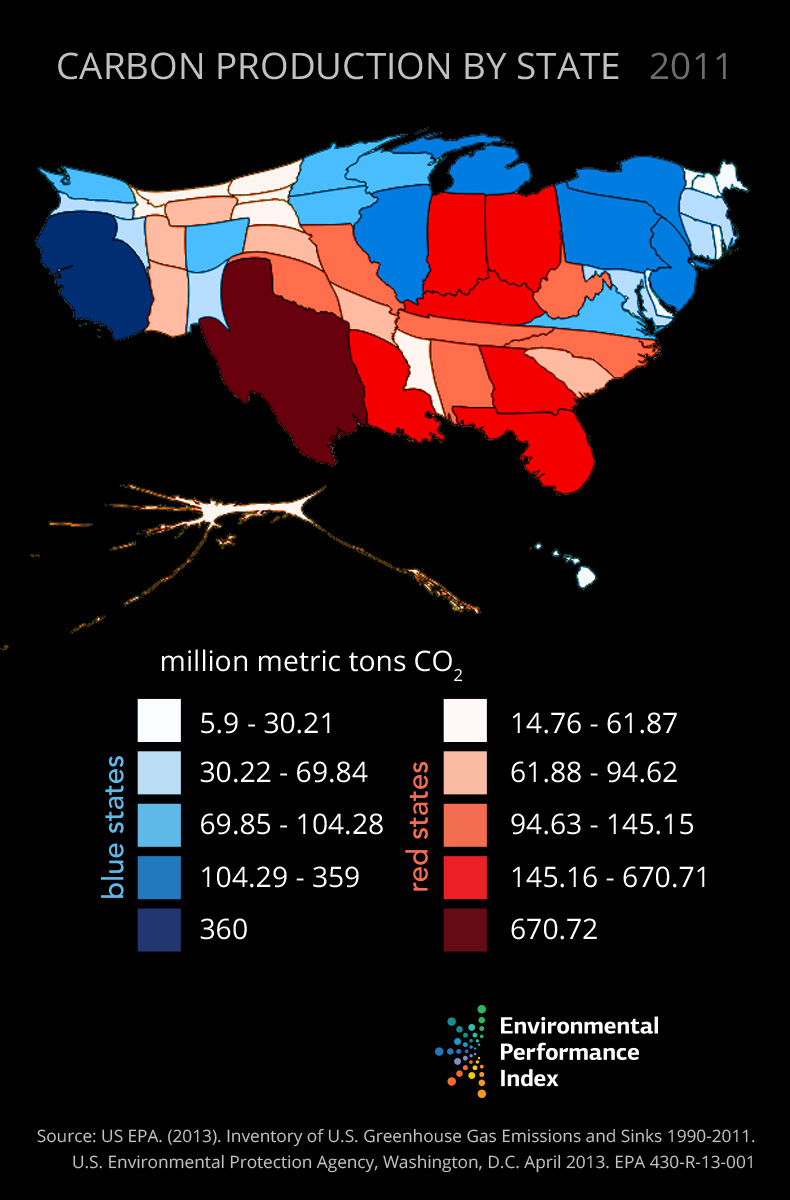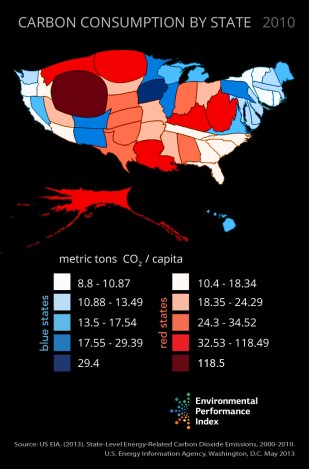On June 2, the Obama administration unveiled its proposal for the nation’s first-ever regulations on carbon dioxide emissions from existing power plants. It’s a bold and potentially groundbreaking move that has environmentalists, public health advocates, and power plant operators mobilizing their supporters or mounting their defenses.
Each year, electric power plants emit about 2.2 billion tons of carbon dioxide — roughly 40 percent of the nation’s total emissions. If successful, the administration’s proposed plan would reduce this sector’s emissions to 30 percent below 2005 levels by 2030. While this goal falls a bit short of environmental advocates’ hopes, it would significantly dent one of the largest sources of carbon emissions from the world’s second-largest producer of greenhouse gases. Many hope that the United States’ action on this issue will also catalyze the international cooperation needed to address climate change on a global scale.
Critics are certain to challenge the administration’s approach in Congress and in court, and have already argued that any climate regulation is an overextension of the Environmental Protection Agency’s authority. Of course, the EPA is uniquely positioned to regulate climate pollution. The migratory nature of air pollution and climate change shakes up the borders between state and federal jurisdiction. For instance, a recent Supreme Court case debated — and upheld — the EPA’s ability to require states to limit soot and smog-forming air pollutants that drift into other states. Climate change presents a similar dilemma: Carbon dioxide emissions from a coal plant in Pennsylvania endanger the Florida coastline, regardless of the political and geographic boundaries between them.
But which states are most likely to contest the proposed regulations — and why? Despite the flexibility in the regulations’ targets and tactics, some states may face steeper practical and political challenges than others. A recent review of statewide carbon emissions from the Yale Center for Environmental Law and Policy (YCELP) found that carbon pollution follows party lines. YCELP’s maps illustrate the “size” of red and blue states according to their carbon emissions. Cumulatively and on a state-by-state basis, red states tend to produce more carbon pollution than blue ones, as you can see in this map.

This distinction holds true in terms of both carbon production and carbon consumption. In other words, Republican states produce more carbon as a byproduct of their economies, and their citizens consume more carbon through the transportation, residential, and commercial activities that shape their lifestyles. Carbon production measures how much states rely on carbon-intensive activities, like energy and electricity production and fuel use, to drive their economies. Production data helps uncover the economic and political motivations behind states’ stances on climate change, but does not account for the ways carbon is exported and imported across state lines. For instance, Idaho and Massachusetts — two of the 10 states with the lowest per capita carbon dioxide production emissions — consistently import electricity. Carbon production totals often overlook these kinds of carbon use.
Information on states’ carbon consumption can help close this data gap; per capita consumption focuses on the ways carbon is incorporated into people’s lifestyles. YCELP considers carbon consumption on a per capita basis — in terms of metric tons of carbon pollution produced or consumed per person — which highlights the ways that state size, population density, and climate also shape states’ rankings. For instance, Wyoming’s cold winters — combined with its status as the lower 48’s most sparsely populated state, and second-most prolific energy producer — create a perfect storm for high per capita carbon consumption. That being said, a tough climate does not necessarily lead to high emissions. Vermont and Maine also face extreme temperatures with sparse populations, but maintain some of the nation’s lowest per capita consumption levels, as you can see in this map.

Carbon consumption may also reveal an area’s ability to get more mileage from its energy use. New York’s very low carbon consumption reflects the large percentage of its population that lives in New York City. Public transit, relatively small living spaces, and other efficiencies of city living lower its residents’ carbon footprints.
While many factors influence carbon use, carbon-intensive economies remain a central predictor of state emissions. As the U.S. Energy Information Administration notes, “The activity of producing energy is itself energy intensive.” Wyoming, North Dakota, Louisiana, West Virginia, and Alaska — five states with energy production at the heart of their economies — also lead the nation in terms of per capita carbon consumption. Energy sources also play into states’ carbon footprints. Sixty-five percent of South Dakota’s net electricity generation comes from wind and hydroelectric power, while neighboring North Dakota relies on more carbon-intensive fuel. In 2013, 79 percent of its net electricity generation came from coal.
The economic strength of states’ ties to carbon may help dictate who will fight the new regulations the hardest — and be most reluctant to curb their footprints if their challenge fails. While some drivers of carbon use — such as Wyoming’s howling winters or New York City’s dense population — may lie beyond state control, politics already influence levels of pollution. Republican states are less likely to implement policies to reduce emissions or increase energy efficiency.
A recent report by CO2 Scorecard found that this gap in political will contributed to higher carbon emissions in Republican states, even after “controlling for the effects of income, prices, industrial structure, climatic conditions and population density.” Since energy efficiency can lower suppliers’ revenue, the report hypothesizes that a combination of political pressure and concern for the industry’s economic role prevents states from supporting it. These circumstances are likely to breed similar reluctance to cuts to carbon dioxide emissions from existing power plants.
However, the proposed regulations tune into — and aim to head off — the challenges raised by the different ways states produce and consume carbon. The EPA’s formula calculates a unique emission-rate standard — a specific ratio of carbon pollution per megawatt-hour of energy produced — for each state. This process accounts for differing abilities to implement efficiency improvements and shift to cleaner energy sources. North Dakota would need to cut the carbon intensity of its electricity production by 10.6 percent, while New York would face a much more ambitious 44.2 percent reduction.
The proposed regulations also give states significant freedom to craft their own roadmaps to reach these targets, by improving the efficiency of existing coal-fired plants; switching to less carbon-intensive energy sources, such as natural gas, wind, or solar; and increasing energy efficiency. States could also join carbon cap-and-trade programs in California and the Northeast, or implement their own carbon tax. By encouraging a range of options that include energy-efficiency measures, the administration heeds the advice of organizations such as the Natural Resources Defense Council, which has argued that considering the electrical system holistically will enable the proposed rules to “achieve steeper cuts at a lower cost.”
Indeed, the economic stakes that complicate carbon reduction also drive some of the most promising approaches to this challenge. The Solutions Project, for instance, examines energy use on a statewide basis, outlining ways to transition each state to a mix of wind, solar, and water power by 2050. While this approach glosses over some of the political and logistical hurdles, it also captures the economic benefits of making the switch. In Wyoming, for example, the Project estimates a move to renewable energy would generate 16,300 construction and 8,300 operation jobs over the next 40 years.
In addition to job growth, reducing carbon pollution improves human health. Emissions from power plants contribute to a variety of public health risks, including heart disease, cancer, stroke, and respiratory illness, leading to 13,000 deaths and $100 billion in health-care costs each year. These considerations have already contributed to the closure of existing power plants in cities like Chicago and Denver. The Obama administration estimates that the proposed reductions in carbon emissions would prevent “6,600 premature deaths, up to 150,000 asthma attacks in children, and up to 490,000 missed work or school days — providing up to $93 billion in climate and public health benefits.”
After a 120-day public comment period, the EPA will revise the proposed regulations, releasing the final standards in June 2015. Whatever shape they take, the attention on existing power plants has the potential to prompt a crucial reckoning of the health, environmental, and economic tradeoffs involved in carbon-intensive energy. The regulations will also test the country’s ability to effect common change across an incredibly varied — and politically polarized — landscape of carbon use.
—–
Political affiliation was determined according to the Cook Political Report’s Partisan Voter Index. Carbon dioxide production data came from the U.S. Environmental Protection Agency’s State CO2 Emissions from Fossil Fuel Combustion. Carbon dioxide consumption data was derived from the U.S. Energy Information Administration’s State-Level Energy-Related Carbon Dioxide Emissions, 2000-2010.
The maps were made by Peter Hirsch of the Yale Center for Environmental Law & Policy, with inputs from William Miao and Sarah Guy.
—–



